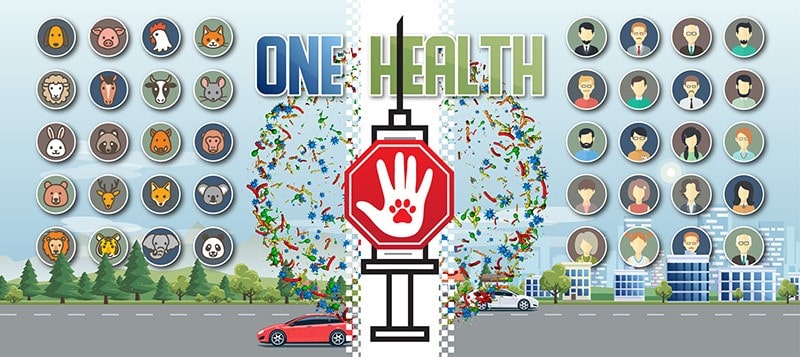
Human and animal contact has never been more prevalent than today, especially with the continued human expansion, reliance on animal products for nourishment, as well as rising population. This animal-human interaction progresses in time as we produce more livestock and companion animals, travel to unexplored regions, and develop cities closer or on previously wild areas - all to meet increasing human demands. As a result of more frequent exposure, diseases contained in the wildlife can now be easily spread to humans.
Infections that spread between animals and humans are called zoonotic infections or zoonoses. These infections can be caused by viruses, bacteria, parasites and/or fungi. It is estimated that 3 out of 4 emerging infectious diseases in people are spread from animals. Microbes have the ability to adapt and change; a zoonotic agent can establish its new life cycle permanently on a human host. Having no prior information to the epidemiology and pathology of this new agent and the resulting disease, an outbreak could occur with no appropriate control measures to contain human-to-human transmission.
Recent Outbreaks Caused by Zoonotic Infection
| Year | Outbreak | Zoonotic Agent | Origin |
| 2014-2016 | West Africa Outbreak | Ebola | Bats* |
| 2009 | Flu pandemic | Influenza Virus (H3N2) | Pigs |
| 2002-2003 | SARS outbreak | SARS-CoV | Bats* |
| 1968-1969 | Hong Kong flu | Influenza Virus (H1N1) | Pigs* |
| 1960-present | HIV pandemic | HIV | Chimpanzees |
*no definitive evidence
One Health approach is a discipline that involves all three systems - human, animal, and environment - for the control of future infectious diseases. Under this approach, an interdisciplinary team aims to predict and prevent the next outbreak through the development of upstream interventions. As these diseases jump across human-animal boundaries, it is more suitable that the countermeasures developed are system-transcending and encompassing.
Role of Vaccines
Vaccines are known to provide protection by triggering the immune response of an individual through the introduction of antigens (present on the target pathogen). The resulting adaptive response to the antigen provides long-term protection and is highly specific to the antigen. This specific feature of our immune system can be a double-edged sword to combat against future infectious diseases. Once antibodies are generated against a specific antigen, future pathogens containing the antigen shall be effectively neutralized. On the other hand, vaccine development is challenging in determining suitable antigen/s that can be protective against an unknown zoonotic agent that has still yet to transmit in humans. Several strategies for vaccination and development are employed under the One Health approach.
Vaccination at the Animal Source
Active monitoring system at the frontline should be prioritized to prevent transmission of diseases from livestock and poultry to the general population. The system should include effective surveillance, prevention, and control of veterinary diseases. Farms should be able to prevent spread of diseases by the safe use of animal vaccines. Furthermore, farms should provide occupational immunization for their workers against potential transmission of animal diseases. These may include: Q fever, influenza, and rabies vaccines. The challenge, however, is that the administration of vaccines to livestock and poultry can get labor-intensive as most vaccines need to be injected individually.
Cross-species Vaccines
Different vaccines have been administered for animals and humans due to safety, differential metabolism, and immune response issues. Adenovirus platform, known to be effective as vector for human gene therapy applications, was used in a study as vaccine vectors also for animals. In the study conducted by Warimwe et. al, a Rift Valley Fever virus antigen was conjugated on a chimpanzee respiratory adenovirus; administration to multiple livestock provided 100% protection. The team also planned to deploy the Rift Valley Fever vaccine for clinical trials.
Better vaccination strategies should be developed under the One Health approach so the global population will be prepared for upcoming outbreaks. Novel vaccines against impending outbreaks should be safely produced in great amounts through the use of bioreactor systems. The goal is to generate cost-effective vaccines that can provide a year-long -or even longer- protection for both animals and humans.
Reference:
Center for Disease Control and Prevention (2017). Zoonotic Diseases. Last accessed 19 June 2019 from https://www.cdc.gov/onehealth/basics/zoonotic-diseases.html
Kim, S. (2018). Challenge for One Health: Co-Circulation of Zoonotic H5N1 and H9N2 Avian Influenza Viruses in Egypt.; https://doi.org/10.3390/v10030121
King, L. (2014). Combatting the Triple Threat: The Need for a One Health Approach.; doi:10.1128/micobiolspec.OH-0012-2012
The Conversation (2019). We're developing the world's first vaccine suitable for humans and livestock. Last accessed 19 June 2019 from https://theconversation.com/were-developing-the-worlds-first-vaccine-suitable-for-humans-and-livestock-115406
21 Changi South Street 1
Singapore 486777
Telephone: +65 6542 0833
Email: [email protected]
About Tide Motion Bioreactors
Tide Motion pertains to the gentle oscillation of culture medium into and out of the matrix vessel that intermittently exposes the cells to aeration and nutrition. The upward oscillation exposes the cells to nutrition, while the downward oscillation exposes the cells to aeration. At the same time, this process washes away products and wastes. This oscillation produces no air bubbles and low shear stress. View a range of products at http://www.vaccixcell.com/tide-technology/
About Esco VacciXcell
Esco VacciXcell is the bioprocessing division of Esco Group of Companies that specializes in the marketing and manufacturing of bioprocessing equipment for cell culture.
Esco VacciXcell provides turnkey manufacturing solutions using its proprietary Tide Motion™ technology to help developing nations to be self-sufficient in the manufacturing, storing, distribution, and administration of vaccines and other biologics, thus providing a complete solution from Discovery to Delivery. For more information on VacciXcell, please visit www.vaccixcell.com